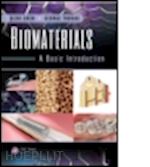Explores Biomedical Science from a Unique Perspective Biomaterials: A Basic Introduction is a definitive resource for students entering biomedical or bioengineering disciplines. This text offers a detailed exploration of engineering and materials science, and examines the boundary and relationship between the two. Based on the author’s course lecture notes and many years of research, it presents students with the knowledge needed to select and design biomaterials used in medical devices. Placing special emphasis on metallic, ceramic, polymeric, and composite biomaterials, it explains the difference between materials science and materials engineering, introduces basic concepts and principles, and analyzes the critically important properties of biomaterials. Explains Complex Theories Using Aspects of Daily Life This text provides an appropriate balance between depth and broadness of coverage, and offers an understanding of the most important concepts and principles to students from a wide academic spectrum. It delivers the science of biomaterials in laymen terms, from a material standpoint, as well as a clinical applications point of view. It equips students majoring in materials science/engineering with knowledge on the fundamentals of how biomaterials behave at a biological level, and provides students majoring in medicine with information that is generally unavailable in traditional medical courses. The authors incorporate learning objectives at the beginning of each chapter, as well as chapter highlights, problems, and exercises at the end of each chapter. In addition, they present objectives, suggested activities, and reference material for further reading. Contains an overview of medical science vis-à-vis materials science, describes anatomy, histology, and cell biology Highlights health issues and diseases where biomaterials can easily find medical applications Presents knowledge of the relationship between the biomaterials and the living body Evaluates medical devices and looks into their respective regulations Biomaterials: A Basic Introduction contains an overview of basic biomaterials and concepts, and is written for upper-division students in the US/Canada, and second-level students in universities worldwide.











